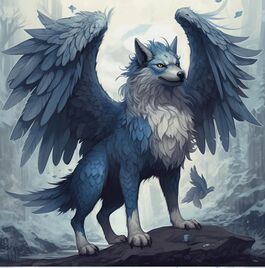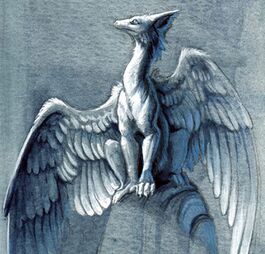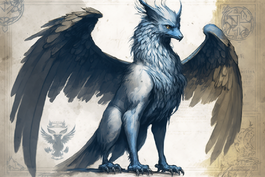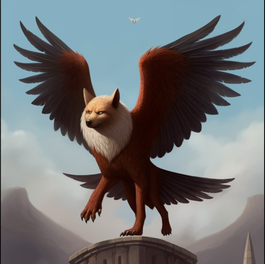Difference between revisions of "The Dragons of Offworld"
Lordraiden (talk | contribs) (→Dragon Facts) |
Lordraiden (talk | contribs) (→Dragon Facts) |
||
| Line 61: | Line 61: | ||
</tr> | </tr> | ||
</table> | </table> | ||
| − | |||
* Due to a unique genetic disorder, created intentionally by [[The Syndicate]] as a means of population control, roughly 9 out of every 10 eggs fails to hatch, and of those that do hatch, only about 1 in 5 infant dragons survive to their 5th birthday. Over a lifetime, a typical dragoness lays one egg per year, starting from around the time they achieve [[Keltess]], up until somewhere around their 900th birthday. This results in each dragon being able to have somewhere between 15-20 total children over their reproductive lifespans. | * Due to a unique genetic disorder, created intentionally by [[The Syndicate]] as a means of population control, roughly 9 out of every 10 eggs fails to hatch, and of those that do hatch, only about 1 in 5 infant dragons survive to their 5th birthday. Over a lifetime, a typical dragoness lays one egg per year, starting from around the time they achieve [[Keltess]], up until somewhere around their 900th birthday. This results in each dragon being able to have somewhere between 15-20 total children over their reproductive lifespans. | ||
Revision as of 21:02, 25 May 2023
 |
|
| Species: | Dragon |
| Home: | Offworld |
| Alliances: | Controllers + Dragon Corps |
| This image provides an example of some of their basic canine features, especially in the face and ears. | |
The Dragons of Offworld are a genetically and technologically enhanced species, which are a chimera blend of numerous different species all blended together into one. The dragons were originally born as the result of a failed genetic experiment several millennia earlier on the world of Ember. However, despite not getting what they wanted, the controllers saw the benefit of their new creation and thus allowed them to live and grow, eventually turning them into TELs, and their loyal servants, and eventually their enforcers on the planet of Offworld.
Description
The basic design of a dragon is as follows: They have a head like that of a Fennec fox with great big, furry ears, a large snout, and large, beautiful, gem like eyes which sits upon a long, muscular neck. On their back rests a set of large, feathery wings that are very graceful in their form and are similar in design to those of an eagle. Their arms and legs are both long, and their front paws are almost hand like and are as dexterous as those of a human being, despite the large, fearsome looking claws that protrude from them. Their body, in turn, is like that of a large cheetah, or even perhaps a tiger; and yet they're very clearly built for flying, with a large, pronounced, muscular chest and a wide, fan like tail that flares open and shut effortlessly like that of a peacock.
Below these feathers are gem like armored scales that cover the dragon's body from eartip to fantail. These, in turn, are covered by soft, gentle feathers that give the dragons an almost furry appearance. Also, all dragons have matching colored feathers and scales, although their eyes can be of different shades than their bodies. Dragons also do not come in gender specific colors, nor is their color determinant on their genetic lineage. This is a side effect of the genetic modification their ancestors underwent in their creation. Dragons, while being TELs, are also chimeras. AKA, they're a genetically modified creature incorporating the characteristics and features of numerous other animals. This has the added benefit of making them stronger, and more powerful as a result.
Dragons are also highly intelligent, and possess reason and logic of their own, which is not given to them exclusively by their implants in the same way it is with biomechanoids, but rather is greatly enhanced, expanded, and improved from its basic, primitive biological form. IE, without the controller implants, they would be no smarter or wiser than your typical animal. But with the implants they possess genius level intelligence equal to, or greater than that of a human being. Dragons, being chimera, and part avian, reproduce by laying eggs. Dragons also only lay or produce one egg per year, and the time from fertilization to laying is about 10 days, and then hatching occurs about 350 days later. A newly laid egg is determined to be viable within the first 7-10 days after hatching. Those that are not are disposed of immediately.
New, freshly hatched baby dragons are immediately taken into the care of a nurse dragon, and looked after for the first few months of their lives, after which they're turned over to their parents for the remainder of their upbringing. This is to ensure the highest rate of survival for all new dragons. Out of a typical cluster of 10 eggs, generally only 1 will either be viable, or survive until hatching, and of those that do successfully hatch, only 1 in 5 will make it past 5 years old. This is because of an intentionally created genetic defect, introduced by the controllers, to prevent overpopulation of the dragons. This shortcoming has a big, negative emotional impact on the females. Some handle it better than others, but all suffer the feeling of loss due to this low mortality rate.
Dragon Aging and Growth
Dragons age differently than humans, and in many ways share a number of similarities in aging to that of dogs. For the first approximately two hundred years of life, dragons age one dragon year for every ten human years. So a dragon who is 50 human years old is only a 5 year old by dragon understanding, and thus the dragon equivalent of a toddler. It is during the first 200 years of their life that they grow to the majority of their adult size, averaging around 5-6ft tall at the shoulder. From this point forward aging slows down, as does growth. From the age of 200 to 500 the rate of aging slows to roughly 1 dragon year for every 15 human years. So if one were to look at the difference in age between Maggy and Garloond, for example, even though they are 100 years different in age, by human understanding, in terms of dragon years, they're actually only about 5 years different in age, with Maggy's age being equivalent to approximately 20 human years old, and Garloond about 25.
Once a dragon passes the age of 500, their aging further slows to about one dragon year per every 20 human years. Following that logic, that would make someone like Narond nearly 85 years old by dragon understanding. Although, even this is, at best, only a guesstimate of a dragon's real age, as every dragon ages differently in the same way that no two dogs age the same. However, as a general rule of thumb, this guide can be applied to most dragons with a reasonable degree of accuracy. A dragon's growth is also determinate on their age range. For example, a new born dragon is not much bigger than about 6-8" at the shoulder, as the size and rate of growth varies widely between dragons, although the average height is about 7" at the shoulder. These then grow slowly to a height of just 24" at the shoulder by age 25 (equivalent to a 2 1/2 year old human). By the age of 50, they have reached a height of around 3ft at the shoulder.
By age 200, they are around 5'6' average, with females tending to average lower, around 5'4", and makes around 5'6". By 300 most are around 6ft at the shoulder. After this age their increase in size continues to decline until near their typical death age of around 1200. Dragons of this age also see a much wider spread of typical heights ranging from 11'5" to a towering 13', with females tending to be 3-6" shorter than their male pears. The oldest known dragon to have ever lived was Weyr Master Narond who reached the ripe old age of over 1450 years at the time of his death. However, he is the extreme exception to the rule, as the vast majority of dragons never see their 1250th birthday.
Dragon Facts
 |
|
- Due to a unique genetic disorder, created intentionally by The Syndicate as a means of population control, roughly 9 out of every 10 eggs fails to hatch, and of those that do hatch, only about 1 in 5 infant dragons survive to their 5th birthday. Over a lifetime, a typical dragoness lays one egg per year, starting from around the time they achieve Keltess, up until somewhere around their 900th birthday. This results in each dragon being able to have somewhere between 15-20 total children over their reproductive lifespans.
- Each dragon, from shortly after they are hatched, are outfitted at various times in their lives, with a series of controller created implants that give them enhanced abilities, such as greater intelligence, the ability to speak and understand any language, to make themselves invisible, reduce or change their weight at will and, in the case of younglings up to a certain size, the ability to teleport. Those who have passed their Keltess generally lose some abilities (such as teleport, as they are too big by then to use the system anymore) and implants, while gaining others that further expand and enhance their already impressive abilities.
- Dragons, especially the elder ones, love playing the game of Plachen, as it helps them while away the time, and keep their minds sharp.
- One of the reasons for the dragons needing an implant that helps them raise or lower their molecular density, thus making themselves either lighter or heavier, is due to their size, and the sizable weight created by their armor covering, which in turn makes them too heavy to fly. It's still possible for them to take to the air if they want, without using this special implant, but flight becomes very difficult, and they tire easily as a result. With the ability to change their weight, the dragons are able to fly, and do many, many things they otherwise couldn't without it.
- Dragons do not eat or drink. The embedded nanites, that maintain their bodies, and provide them with their advanced abilities, including healing and more, also provides them with all of the necessary fluid and nutritional needs their bodies require. This includes the expunging of waste products without the need for urination or defecation. In this same way, nutrients are created inside of, and delivered to the body to maintain their nutritional needs. This is achieved through materialization and replication of required elements as needed, or the conversion of waste products back into either energy, or usable bio-products as needed.
- Dragons have the ability to fully cloak themselves so that not even their own kind can find them. But they can also generate selective cloaking, allowing other fellow dragons, whom they choose, to be able to see them. However, dragon's are unable to cloak any items or objects that are not a direct part of their body, such as items placed on their bodies, or held in their hands.
- Dragons possess a built in healing system that uses special energies to trigger and generate rapid healing in a target organism. This healing system can either be used on themselves, or someone else whom needs their assistance. And, while all dragons can heal others, some dragons specialize in this skill, taking their ability far above and beyond what most other dragons can do.
 |
|
- One of the numerous implants that the dragons are given throughout their lives is a holographic communications and information system. This allows them, through the micro-mainframe implanted in their bodies, to speak face to face, through a holographic communication system, with other equally equipped individuals, be they dragon, controller or otherwise. This same system is also available to human racers, but this fact is not generally known among the participants in The Race of Offworld unless someone specifically tells them, as the controllers normally do not share this useful bit of information with them, unlike those who are their direct servants.
- Just like the racers who are brought to Offworld, dragons also have an identifier chip embedded in their left wrist. This is to both identify them to their masters, and as a means to access controller resources, activate certain of their implants, initiate holographic communications and more.
- Dragon implants, being as powerful as they are, necessitate the inclusion of an internal power source, and are thus powered in one of two ways. For young dragons who are not large enough, or have not completed their Keltess, their implants are powered by a small, rechargeable plasma cell embedded in their bodies. This is usually sufficient to power all of their implants for anywhere from several days to several weeks, depending on their usage. After this they must return to a dragon weyr to recharge again. Older dragons and those who have completed their Keltess, their power cell is replaced by a small, stand alone Quantum Reactor. This device is self sustaining and never needs maintenance, typically lasting the life of the dragon without need for repair, refueling or maintenance. Larger dragons, such as some of the elders, who grow too large for the original reactor to supply all their power needs may be given a second one to supplement their power needs.
- Dragons are considered to be "hot blooded", not because of their temperament, as they tend to be naturally kind and gentle creatures (although they can become very angry and violent when required), but rather because their body temperature runs high compared to other animals, with their internal temperatures running between 140F and 160F on average. Due to this, and the natural regulating effects of certain among their implants, they never get to hot or too cold, and thus can tolerate a wide range of temperatures without issue. Older dragons, however, tend to get cold much easier than younger dragons, thus facilitating their need for blankets and large, insulated mats from time to time to help them stay warm in the cold, unforgiving stone walls and floors of their weyrs.
- One of the abilities of the dragons, via their implants, is the capability to generate a defensive energy shield. This is an extension of their cloaking system and can, unlike their cloaking system, be used to shield other individuals or objects as they have need. Any dragon, be they youngling or adult, have this ability, although the strength, complexity, versatility and operational duration vary by age.
- Dragons have technologically enhanced eyesight, allowing them to see in the dark in the same way that night vision gives humans the ability to see at night. While, not a perfect technology, it has its advantages, especially when the dragons are doing night raids.

